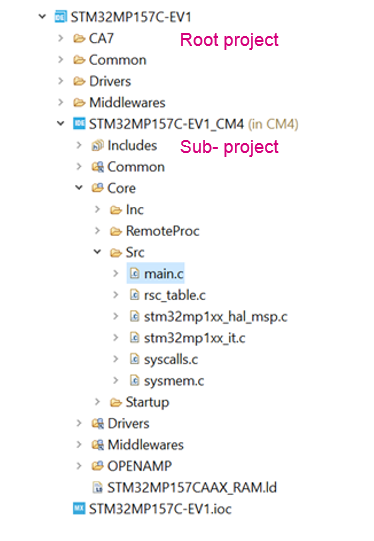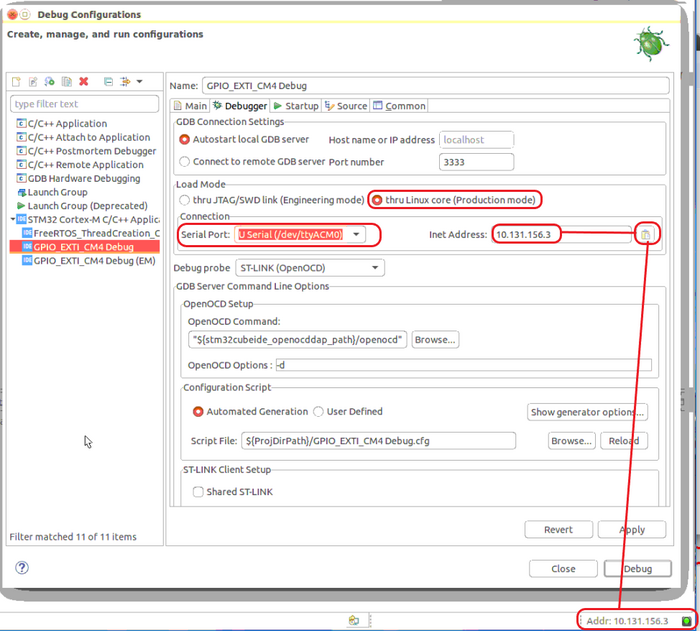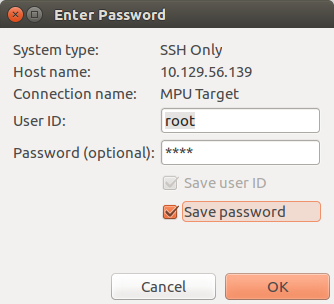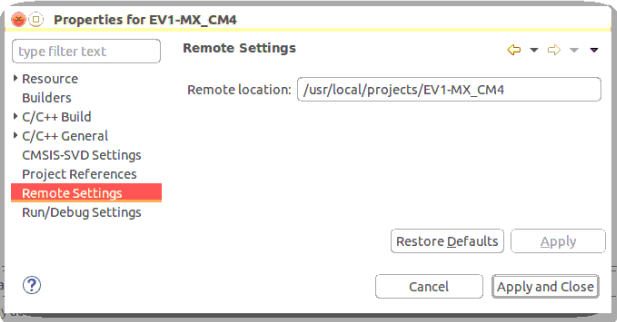This article explains some of the basics of STM32CubeIDE. It is an all-in-one multi-OS development tool, which is part of the STM32Cube software ecosystem.
For more information about STM32CubeIDE please refer to its user manual.
1. STM32CubeIDE purpose[edit source]
STM32CubeIDE is an advanced C/C++ development platform with peripheral configuration, code generation, code compilation, and debug features for STM32 microcontrollers and microprocessors. It is based on the ECLIPSE™/CDT framework, GCC toolchain for the development and GDB for the debugging.
It allows the integration of the hundreds of existing plugins that complete the features of the ECLIPSE™ IDE. STM32CubeIDE integrates all STM32CubeMX functionalities to offer all-in-one tool experience and to save installation and development time.
With STM32CubeIDE, you can
- select the appropriate STM32 device corresponding to your needs,
- configure the device using STM32CubeMX,
- develop and debug applications on top on Arm® Cortex®-M
2. Prerequisites[edit source]
To take all advantages of explanations given in the wiki page and to develop some application based on the STM32 MP1 Series, following packages must constitute the development environment :
- STM32CubeIDE v1.1.0 or newer
- STM32CubeMP1 Package v1.1.0 or newer
- STM32CubeMX v5.4.0 or newer
3. How to install STM32CubeIDE[edit source]
| STM32CubeIDE for Linux® host PC | STM32CubeIDE for Windows® host PC | |
|---|---|---|
| Download |
Version 1.3.0
|
Version 1.3.0
|
| Installation guide | ||
| User manual | ||
| Detailed release note |
| |
4. How to get started with STM32CubeIDE[edit source]
This section links to two different how to articles depending on if you are moving from SW4STM32 to STM32CubeIDE or if you are starting a new project with STM32CubeIDE.
4.1. How to get started with STM32CubeIDE from scratch[edit source]
How to get started with STM32CubeIDE from scratch.
4.2. How to move from SW4STM32 to STM32CubeIDE[edit source]
How to move from SW4STM32 to STM32CubeIDE.
5. Project structure[edit source]
A hierarchical project structure is created in same time as the creation of an STM32 MPU project.
The project structure for single-core projects is flat. On the contrary, in a multi-core project, the hierarchical project structure is used. When the user creates or imports an STM32 MPU project, its structure is made of one root project together with sub-projects, referred to STM32 MCU projects, for each core. A hierarchical structure example is shown below.
6. Arm® Cortex®-M debug on STM32 MPU device[edit source]
Two modes are used to debug Arm® Cortex®-M firmware on STM32 MPU device.
6.1. Engineering mode[edit source]
Very powerful to debug preliminary Arm® Cortex®-M, the engineering mode implies a specific boot mode: the Engineering Boot Mode where only Cortex-M is started. Firmware is loaded via JTAG/SWD into its dedicated RAM.
This mode is not the default one, it has to be set via the "Debug Configuration" menu, in "Debugger" tab , "thru JTGA/SWD link (Engineering mode)" option selected.
Debugging in Engineering Mode in STM32 MPU device is very similar to a standard STM32 MCU debug in term of functionality, expect that here Arm Cortex-M has only a dedicated memory, no flash memory type.
6.2. Production mode[edit source]
Production mode targets a debug close to final product. It means to have an STM32 MPU board up and running on the Cortex-A (Linux) and a Cortex-M firmware to debug (usually an STM32CubeIDE project).
Board, aka named as "target", is booted in Production mode from flash memory (e.g. SD card) ; it is connected to the Host:
- via Ethernet network, using Ethernet cable or dedicated USB cable
- and via USB cable to ST-Link probe, giving access to JTAG/SWD and Linux Console.
ST-Link automatically brings support for Cortex-A Linux console via VCP (Virtual COM Port). This enables Target Status widget, visible on the bottom-right of STM32CubeIDE, allowing target IP address discovery. For Production Mode setup, it is recommended to get the target IP address discovered by Target Status widget before creating Debug Configuration. This principle is depicted in Debug Configuration screenshot below.
Network connection can be set up by 2 ways:
- Ethernet
- managed network: IP address attributed by DHCP server
- unmanaged network: IP address to be manually configured
- USB
- using the dedicated USB OTG connection for Ethernet point to point.
Debug is performed thanks to the following workflow:
1. The firmware built binary is transferred to the target using the network (ssh protocol), more precisely to the Cortex-A Linux file system.
2. The firmware is loaded to Cortex-M core thanks to the “remoteproc” framework.
3. Finally the Debug session is started via JTAG/SWD connection
The production mode is the default one when you create a new debug configuration. It is automatically set via the "Debug Configuration" menu.
More information on how to use STM32CubeIDE Target Status are given in article How to use the STM32CubeIDE target status.
At debug launch, some specific pop-up appear:
- The SSH Password has to be completed: the default one is root.
- The RSA key has to be approved.
Defining an Arm Cortex-M project in an STM32 MPU context also means to define where are downloaded on Arm Cortex-A Linux file system:
- the Cortex-M Firmware: <ProjectName>.elf
- the load/unload script fw_cortex_m4.sh used by the STM32CubeIDE if present it can be customized
- and a README, informing a user having a direct connection onto the target.
This is the purpose of "Remote Path Setting" property which is linked to the project. Its default value at creation is /usr/local/project/<ProjectName>, but can also be changed thanks to the Remote Settings properties item.
Inside project structure,directory "<ProjectName>_CM4/Core/RemoteProc/" defines the tree downloaded when debugging in Production Mode.
6.3. ST-Link Server support[edit source]
From STM32CubeIDE v1.2.0, it is possible to connect to ST-Link via ST-Link Server just like on standard STM32 MCU. This is enabled by checking "Shared ST-Link inside Debug Configuration > Debugger > ST-Link Client Setup".
7. FAQ[edit source]
| Coming soon |




